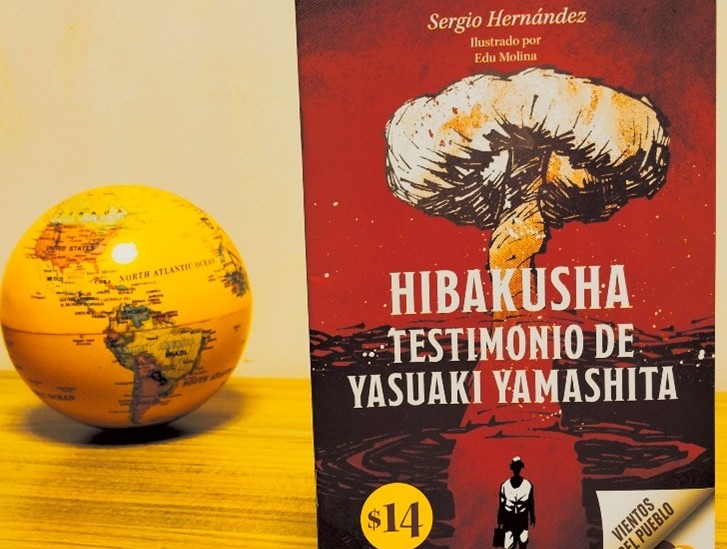【Mexico City INPS Japan=Guillermo Ayala Alanis】

At just six years old, Yasuaki Yamashita witnessed a tragedy so horrific that even the word hell fails to capture its true horror. For fifty years, he remained silent about his pain, until he finally found solace in sharing his story. (P-29)|SPANISH|JAPANESE|
“If we stop talking about what happened, history can repeat itself anywhere in the world… we don’t want anyone to suffer what we suffered.”
Nearly 80 years ago, Yasuaki Yamashita survived one of the most terrifying events ever inflicted by humanity—the atomic bombing of Nagasaki. The devastation was so grotesque, so cruel, and so overwhelming that words alone cannot convey the depth of suffering. Yamashita recounts this horror in his book, Hibakusha. Testimony of Yasuaki Yamashita.
A Collaborative Effort to Preserve Memory

The book was authored by Sergio Hernández, a professor and researcher at Mexico’s National Institute of Anthropology and History (INAH). Published in 2021, it captures Yamashita’s testimony as a hibakusha—the term used to describe survivors of the atomic bombings in Japan.
This project is the result of a decade-long friendship and professional collaboration between Hernández and Yamashita in Mexico. Their shared mission is to educate people, particularly younger generations, about the catastrophic consequences of nuclear weapons.
“The idea was to provide context in schools—based on my research, my knowledge of Japan’s wartime situation and its conflict with the United States, and the consequences of the atomic bomb,” Hernández explained in an interview with INPS Japan. “Yasuaki’s part is about sharing his experience, but more importantly, it’s about promoting a culture of peace and advocating against the production of nuclear weapons.”
To spread this message, Hernández and Yamashita have presented the book in elementary schools, high schools, and universities across Mexico. They have also taken their advocacy to state congresses, bookstores, and book fairs, ensuring their message reaches a broad audience.

A Book That Resonates Across Latin America

Hibakusha. Testimony of Yasuaki Yamashita was published by Fondo de Cultura Económica (FCE), a leading publishing house with a strong presence in Latin America and Spain. The book is available in Argentina, Chile, Colombia, Ecuador, Spain, Guatemala, Peru, and the United States.
It is part of FCE’s Vientos del Pueblo (Winds of the People) collection—a series of nearly 100 books designed to make important texts accessible to a wide audience at an affordable price of just $11 to $20 pesos (less than $1 USD).
The book’s impact is magnified by its fluid storytelling and the raw, haunting details of Yamashita’s account. He describes how the atomic bomb produced a blinding flash equivalent to a thousand lightning bolts and how survivors endured inhuman conditions of sickness and starvation in its aftermath.
Illustrations That Bring the Tragedy to Life
In addition to the powerful narrative, the book features a series of nine evocative illustrations by FCE artist Edu Molina. His drawings emphasize facial expressions of despair, anguish, fear, and sorrow—yet also manage to convey a sense of hope.
“I felt the book was very raw, so the illustrations needed to be shocking. But at the same time, there had to be an element of optimism,” Molina explained. “Toward the end, there’s a sense of hope—a realization that something can be learned from the horrors of World War II.”

The Artistic Process Amidst Adversity
In another INPS Japan interview, Molina revealed that he created the illustrations during the COVID-19 pandemic, while also recovering from a severe arm injury that restricted his ability to draw. However, he turned this challenge into an advantage.
“I had a semi-useless hand, but one of the benefits of drawing is its immediacy—you don’t need excessive detail or aesthetic distractions,” he said. “As they say in martial arts, I used the enemy’s strength to my advantage. Every time I look at the book, I see creative virtues that I wouldn’t have discovered if I had been completely healthy.”
A Book in High Demand
Hibakusha. Testimony of Yasuaki Yamashita has received overwhelming support from readers in Mexico. In fact, it is the only book in the Vientos del Pueblo collection to be reprinted three times, bringing the total number of copies to 40,000—a testament to its powerful message and high demand.
Reflecting on the growing public interest in nuclear disarmament, Sergio Hernández noted:
“The role that society is taking on in this issue is both significant and distressing. It shows that the threat of nuclear weapons is no longer abstract—it is real and pressing, something that wasn’t as strongly felt just a few years ago.”
Mexico: A New Beginning for Yamashita
For Yasuaki Yamashita, Mexico has been a place of rebirth. Arriving in the country in 1968, he gradually learned the language, adapted to the culture, and fell in love with his new home.
Yet, it took him five decades before he could finally talk about his experience in Nagasaki. His first public testimony took place at a university in Querétaro, a moment that changed his life.

“As I finished speaking, I realized my pain was fading. For fifty years, I had hidden this terrible suffering inside me. But at that moment, I told myself: This is my therapy. I have to speak to heal the wounds that have consumed me for so long,” he recalls in one of the book’s excerpts.
A Testament to Memory and Hope
Through his book, his lectures, and his activism, Yamashita continues to ensure that the voices of hibakusha are not forgotten. He and Hernández are not only preserving history but also inspiring future generations to work toward a world free of nuclear weapons.
This article is brought to you by INPS Japan in partnership with Soka Gakkai International, in consultative status with UN ECOSOC.
INPS Japan



